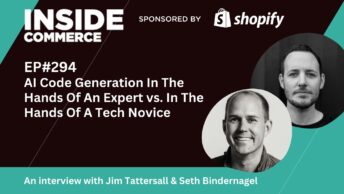An interview with CEO Alan Gormley on how Shopbox builds a deep understanding of in-store shopping behaviour to drive results through smart merchandising strategies.
Listen on your favourite player
Watch the video
Tl;dr
- Why AI merchandising tools need to behave like in-store sales assistants not product sales agents
- How Shopbox differs to other Ai/ML merchandising and recommendation engines
- Business tooling and business rules to control merchandising strategies
- Product roadmap focus
Shopbox is an AI-powered adaptive shopping experience platform. It transforms a generic online store into one that learns about each individual visitor, including the 95% that are anonymous traffic. From their very first click, it begins to assist, curate and advise, constantly adapting in real-time throughout their entire shopping journey. By presenting relevant permutations based on their interests and behaviour, it provides a uniquely tailored shopping experience.
Tune in for practical insights from CEO Alan Gormley into how Shopbox is being used by retail ecommerce businesses.
Discussion notes
- We talked about the majority of the buying cycle taking place outside the ecommerce store, how do retailers need to adapt their thinking?
- I like how you frame things around wanting your AI to act like an experienced store sales person, watching, really getting to know the customer – how do you think this differs from the standard approach to AI driven personalisation?
- Let’s get into the details of your platform, how is Shopbox different, how are you addressing the limitations you see with the application of AI on an ecommerce store?
- What data does it pull in to properly understand the customer profile and how does this translate into understanding user needs/intent?
- “AI-powered adaptive store for a tailored shopping experience like no other” sounds like marketing speak! Can you break this down into tangible outcomes – what is tailored and why is this unique compared with what other AI/ML tools provide?
- What does “engage Customers from the First Click” really mean – what engagement tactics can ecommerce teams achieve before they know about the visitor?
- Can you talk us through your “For You” personalised page – how is it collecting data, what personalisation can be presented, how does it change as it learns more about the customer?
- How does your engine handle anomalies and outliers to avoid false positives e.g. I make a one-off purchase every year for my wife’s birthday, don’t now cram For You with recommendations for her!
- What tooling does the platform have to overlay business rules to control product associations, as some multi-brand retailers have brand guidelines they have to adhere to?
- What effort and resource is needed from retailers – what skills are essential to get the most from the platform, what tasks do ecommerce teams perform vs. what’s automated
- Integration: is this JS or do you have APIs, how do you assess the impact on page performance, for example Schuh uses API for cross sell in basket, to avoid having 3rd party JS?
- Future: integration into other channels like chat systems, native Klaviyo integration – what’s coming next?
Want to suggest a topic or guest for a future episode? Contact us via the website or on LinkedIn.





